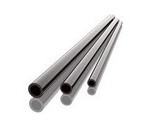Glassy Carbon (CAS 7440-44-0) is Exciting Material for Research & Production Applications
23 May 2012 • by Natalie Aster

Glassy carbon (also called vitreous carbon) is an advanced material of pure carbon combining glassy and ceramic properties with these of graphite; and has a molecular formula of CH4. It is stable under normal temperatures and pressures; melting at 3550 °C and boiling between 500 °C and 600 °C. Glassy carbon is incompatible with strong oxidizing agents like chlorates, bromates and nitrates, especially when heated; it is also incompatible with air, metals, unsaturated oils.
Glassy carbon was first observed in the mid-1950s by Bernard Redfern, the inventor, materials scientist and diamond technologist. Working in the laboratories of The Carborundum Company in Manchester, the UK, he discovered a resole resin that would, with special preparation, set without a catalyst. Using this phenolic resin, crucibles were produced.
Unlike graphite, glassy carbon has a fullerene-related microstructure, which leads to a great variety of unique material properties.
Thus, glassy carbon is very advantageous for many different applications in the chemical industry. Also, compared to ceramic and metallic materials, glassy carbon shows no embrittlement even at high temperatures (up to 3000°C).
Its non-wetting characteristics make glassy carbon the ideal approach for certain otherwise difficult-to-evaporate materials. For instance, it does not suffer from the annoying alloying problems when evaporating precious metals with tungsten boats.
Glassy carbon crucibles and boats are used for zone melting of semiconductor components, gallium arsenide synthesis, and monocrystal growth by the Bridgman or Czochralsky method. Glassy carbon is used for parts in ion implanting systems and electrodes for plasma etching systems due to its extreme resistance. The high X-ray transmission of glassy carbon is advantageous for the X-ray lithography. Glassy carbon wafers are used as substrate materials for X-ray masks.
Glassy carbon market is covered in the study Glassy Carbon (CAS 7440-44-0) Market Research Report 2012. The report encompasses proper description of the product, unveils application areas, and briefly summarizes patents in the sphere. It overlooks glassy carbon market situation, names manufacturers, suppliers as well as users. The report also provides current glassy carbon prices in the market.
More information on the glassy carbon market can be found in the report “Glassy Carbon (CAS 7440-44-0) Market Research Report 2012”.
Contacts
MarketPublishers, Ltd.
Tanya Rezler
Tel: +357 96 030922
Fax: +44 207 900 3970
[email protected]
MarketPublishers.com
Analytics & News
